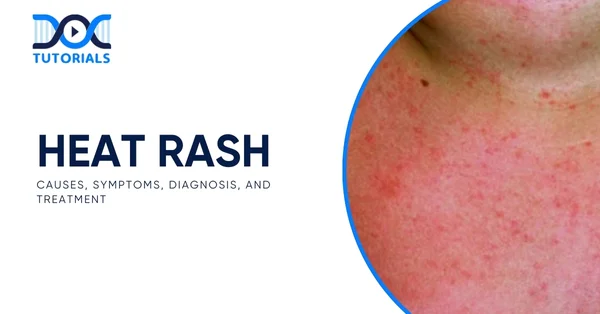Heat Rash: Causes, Symptoms, Diagnosis, and Treatment

Heat rash can happen to anyone, not just babies, and is most likely to occur in hot, humid weather. While generally harmless and self-limited, in severe instances, they can be uncomfortable and disrupt daily activities.
For NEET PG aspirants, understanding heat rash is important because recognising its causes, symptoms, and management builds a strong base in dermatology and patient care.
What is Heat Rash?
Heat rash is a skin irritation that happens when sweat gets trapped below the skin. It usually manifests during hot, humid conditions and affects both adults and children.
There are three common types:
- Miliaria Crystallina – This occurs if the sweat ducts get blocked at the surface of the skin, which results in the formation of tiny, clear, fluid-filled bumps that easily break. It is usually painless and vanishes almost immediately.
- Miliaria Rubra – Commonly called prickly heat, it forms tiny, red, inflamed bumps that cause itching or a prickling sensation. When the bumps get filled with pus, it is called miliaria pustulosa.
- Miliaria Profunda – The rarest and most severe type, it affects the deepest layer of skin (dermis) to cause firm, painful, or pruritic bumps like goose bumps that also may break open. However, most of the time, it resolves naturally as the skin starts to cool down and sweating decreases.
What Causes Heat Rash?
Heat rash develops when sweat gets trapped beneath the skin instead of evaporating. Usually, the sweat from the sweat glands flows through minute tubes called sweat ducts to the surface of the skin, from where it exits through pores and cools the body.
When these ducts become blocked or inflamed, sweat cannot exit and instead flows back into the skin, causing irritation and creating small bumps or blistering.
Blockages in sweat ducts can result from:
- Excessive Sweating: Sweat trapped between skin and clothing blocks pores.
- Dead Skin Cell Buildup: Softened skin from continuous sweating makes dead cells more susceptible to blocking sweat ducts. Such blockage causes an inflammation of either the outer layer (epidermis) or the middle layer (dermis) of the skin, resulting in heat rash.
What are the Risk Factors of Heat Rash?
Certain factors increase the likelihood of developing heat rash, particularly in hot and humid environments. Some people are naturally more prone due to their age or health condition, or even their environment.
Major risk factors include:
- Age: Newborns, infants, and toddlers are actually at a greater risk due to the developmental stage of their sweat glands. Tight clothing, swaddling, or diapers can trap heat and reduce air circulation.
- Climate: If you live in a hot and humid climate, you may sweat excessively, which can increase the likelihood of sweat duct blockage.
- Physical activity: Vigorous workouts or heavy manual labour, especially when done in heat, predispose sweat ducts to blockage.
- Bed Rest and Fever: A rash may develop in individuals who are on bed rest for extended periods, especially with fever, on the back or pressure areas due to prolonged contact with bedclothes and reduced air circulation.
- Medical Conditions: People with hyperhidrosis (excessive sweating) are more susceptible to sweat duct blockage.
- Certain Medications: Drugs like beta-blockers, opioids, or clonidine can stimulate sweat production, increasing the risk of heat rash.
- Tight Clothing: Clinging or non-breathable clothing blocks the release of sweat and heat from the skin in hot weather or during exercise.
What are the Heat Rash Symptoms?
Heat rash causes a very uncomfortable irritation of the skin that may feel burning, itchy, or prickly. This rash typically appears in areas with poor airflow or constant friction, such as under tight-fitting clothing or in skin folds. It is commonly seen:
In Adults:
- Under the breasts or chest
- Inner thighs and legs
- Back and arms
In Infants:
- Neck and shoulders
- Armpits and elbow creases
- Upper chest, back, and diaper area (groin)
How is Heat Rash Diagnosed?
A simple skin inspection can diagnose heat rash. A doctor can examine the affected skin and ask questions about the symptoms, appearance, and level of discomfort. There may be questions related to your medical history, recent medications, or any activities such as exercise or exposure to hot weather.
The doctor may also make a differential diagnosis if he needs to exclude other rashes similar to heat rash, such as:
- Bug bites
- Chickenpox
- Drug allergy rashes
- Eczema or dermatitis
- Folliculitis
On the other hand, transient neonatal pustular melanosis (TNPM) looks similar to heat rash but occurs mostly in newborns with brown or black skin.
In the majority of cases, tests will not be required unless your doctor suspects another underlying condition.
What are the Heat Rash Treatment Options?
Most heat rash cases are mild, resolving quickly with simple treatment at home. As soon as the skin temperature drops, the rash usually starts to get better.
Steps to treat heat rash include:
- Keep sweating to a minimum by finding a cooler space or an air-conditioned room.
- Remove or loosen the clothing that covers the affected area.
- Very gently wash the skin with cool or lukewarm water, and then pat it dry until it is just slightly damp. It is crucial not to scrub the skin.
- Do not cover the skin. Wear clean, loose clothes that will not rub against the area.
These remedies work for both adults and children. Heat rashes in infants generally clear up by themselves.
Are there any Potential Complications of Heat Rash?
Heat rash usually heals without scar formation; the most common complication is bacterial infection in the skin, occurring after scratching causes minute breaks in the skin through which bacteria enter.
Signs of infection may include:
- Swelling or warmth around the rash
- Formation of inflamed, itchy pustules
- Fever, chills, or nausea in severe cases
How to Prevent Heat Rash?
Keeping the skin cool and dry, with adequate air circulation, is the best way to prevent heat rash, especially in hot and humid conditions or for individuals working outdoors and sweating.
To avoid heat rash, consider the following:
- Wear loose, light, and airy clothes that allow your sweat to evaporate. Cotton is preferable to synthetics. Do not overdress your newborns or bundle them up in several layers of clothing.
- Restrict any physical activity at the hottest time of the day; take frequent breaks in the shade or air-conditioned areas.
- Use fans or AC to keep your living and sleeping area cool and properly ventilated.
- Avoid any creams or ointments that could block pores, allowing sweat to remain trapped under the skin.
- Be aware of medication types that might increase sweating, such as clonidine, beta blockers, or opioids, and speak to a doctor about alternatives if needed.
FAQs About Heat Rash
- What causes heat rash?
Heat rash occurs when sweat ducts become blocked or inflamed, trapping sweat under the skin rather than allowing it to evaporate from the surface normally. This causes irritation that results in redness and tiny bumps.
- How is heat rash diagnosed?
Doctors usually diagnose heat rash by looking at the skin. They appear as tiny 2–4 mm spots, sometimes filled with fluid, and on brown or black skin, they may look grey or white, making them difficult to spot.
- What is the best treatment for heat rash?
Most heat rashes disappear on their own if the skin is cooled and sweating stops. To relieve itching or inflammation caused by heat rash, a doctor or pharmacist may recommend mild topical medicines.
- Is heat rash fungal or bacterial?
Heat rash itself is not always infectious, but sweat rash (candida intertrigo) can develop if yeast or bacteria proliferate in warm, moist skin folds. These generally form in hot and humid conditions.
Conclusion
Most of the heat rashes resolve naturally without any complications if the skin remains cool and dry. However, watch out for signs of infection such as fever, swelling, or pus, all of which may need to be treated by a doctor and antibiotics.
NEET PG aspirants can access a vast library of such topics, including high-quality video lectures, question banks, test series, and expert mentorship through the NEET PG courses by DocTutorials.
Start learning for NEET PG with DocTutorials today and march confidently towards passing your exams!
Latest Blogs
-

NEET PG Exam 2025- Date, Pattern, Marking Scheme, Subject Wise Weightage, and Exam Mode
NEET PG Exam 2025 is the ultimate gateway for medical graduates aspiring to pursue postgraduate courses in medicine, including MD,…
-

INI CET Exam 2025: Your Roadmap to Success – Key Topics, Strategies, and Lessons from Last Year’s Papers
The INI CET exam is more than just a test; it’s a significant milestone for many medical students aiming to…
-

INI CET Exam Success: Previous Year Question Papers & Ultimate Guide – INI CET PYQ
One can feel overwhelmed while preparing for the INI CET (Institute of National Importance Combined Entrance Test). A vast syllabus,…




